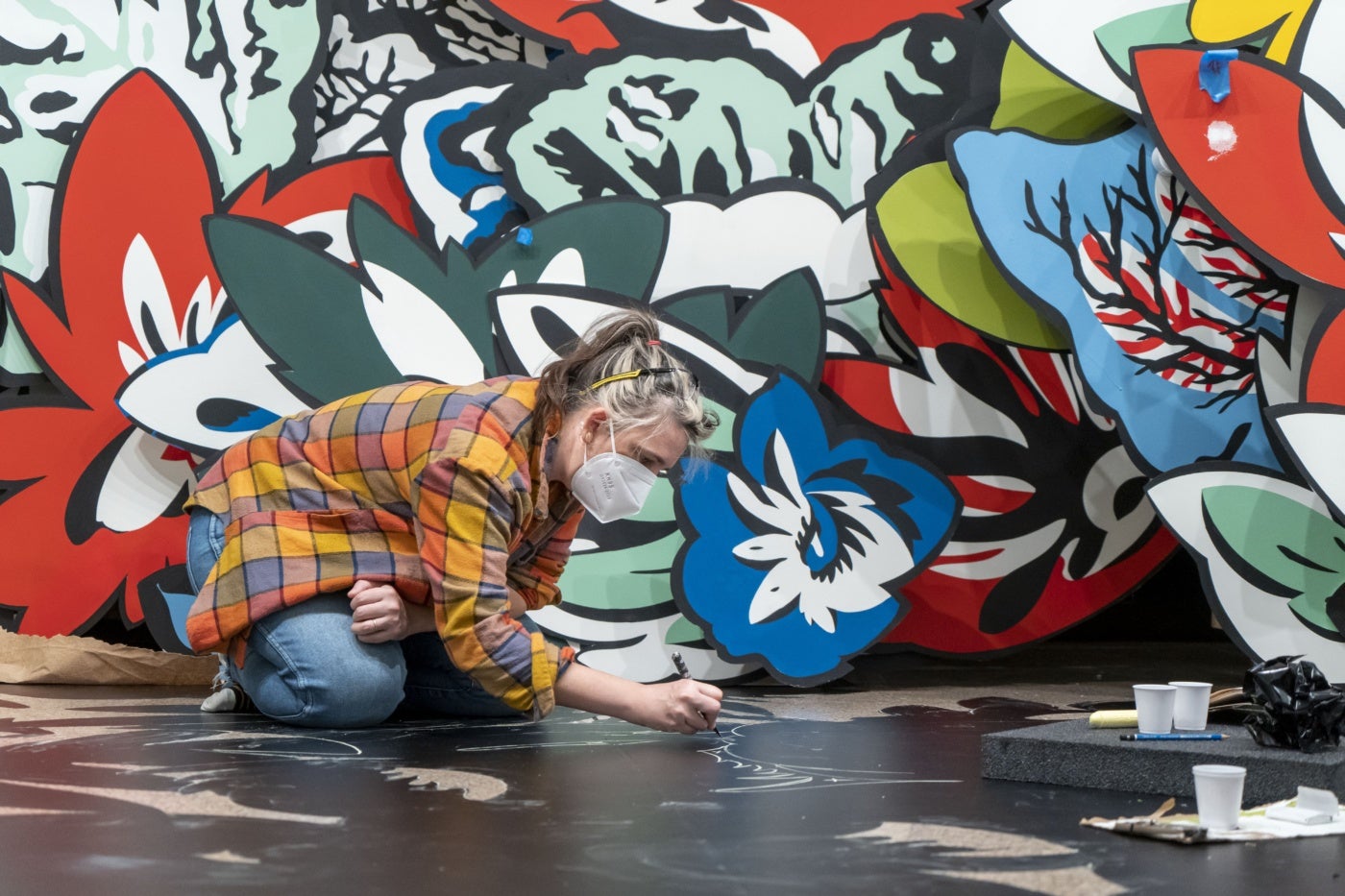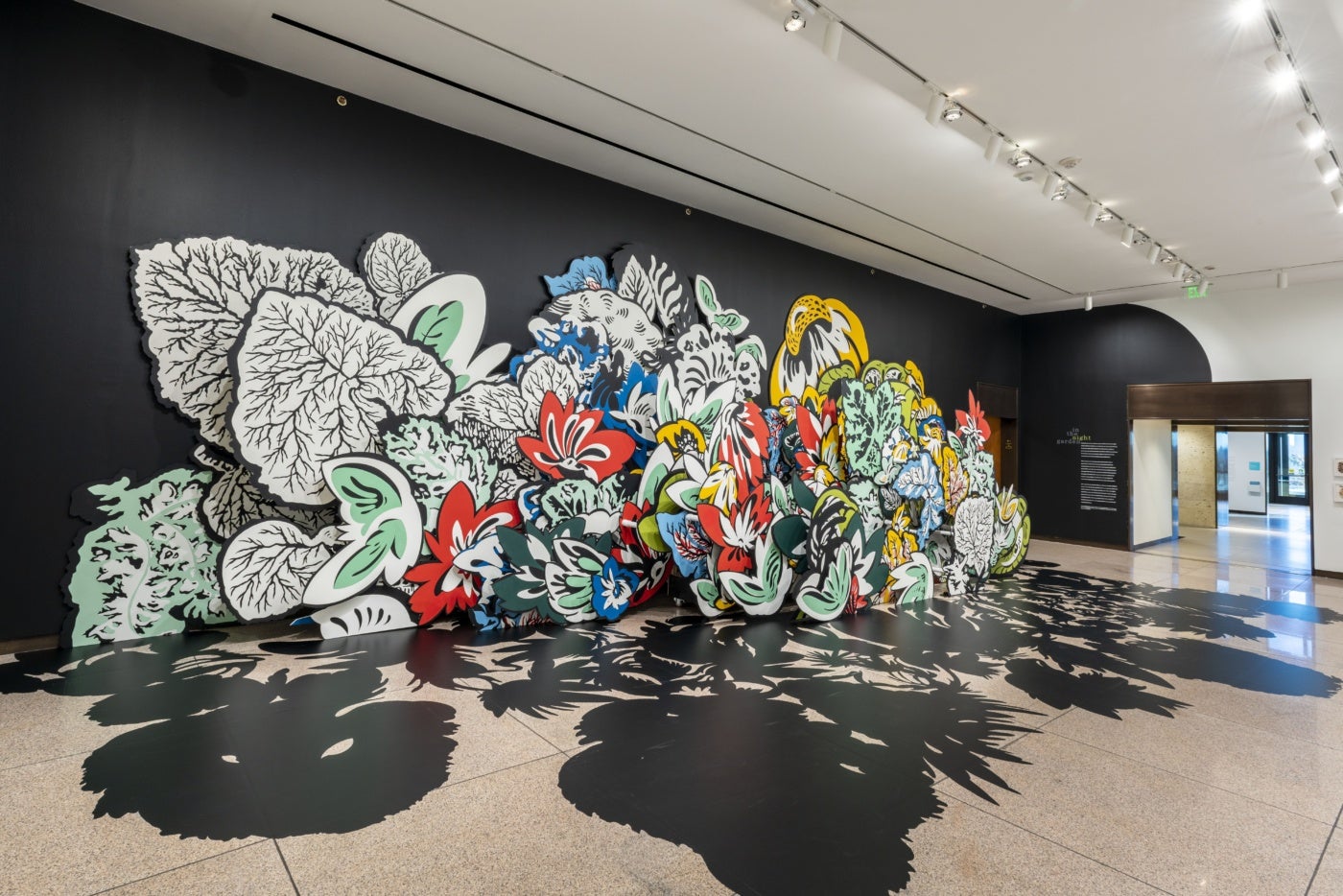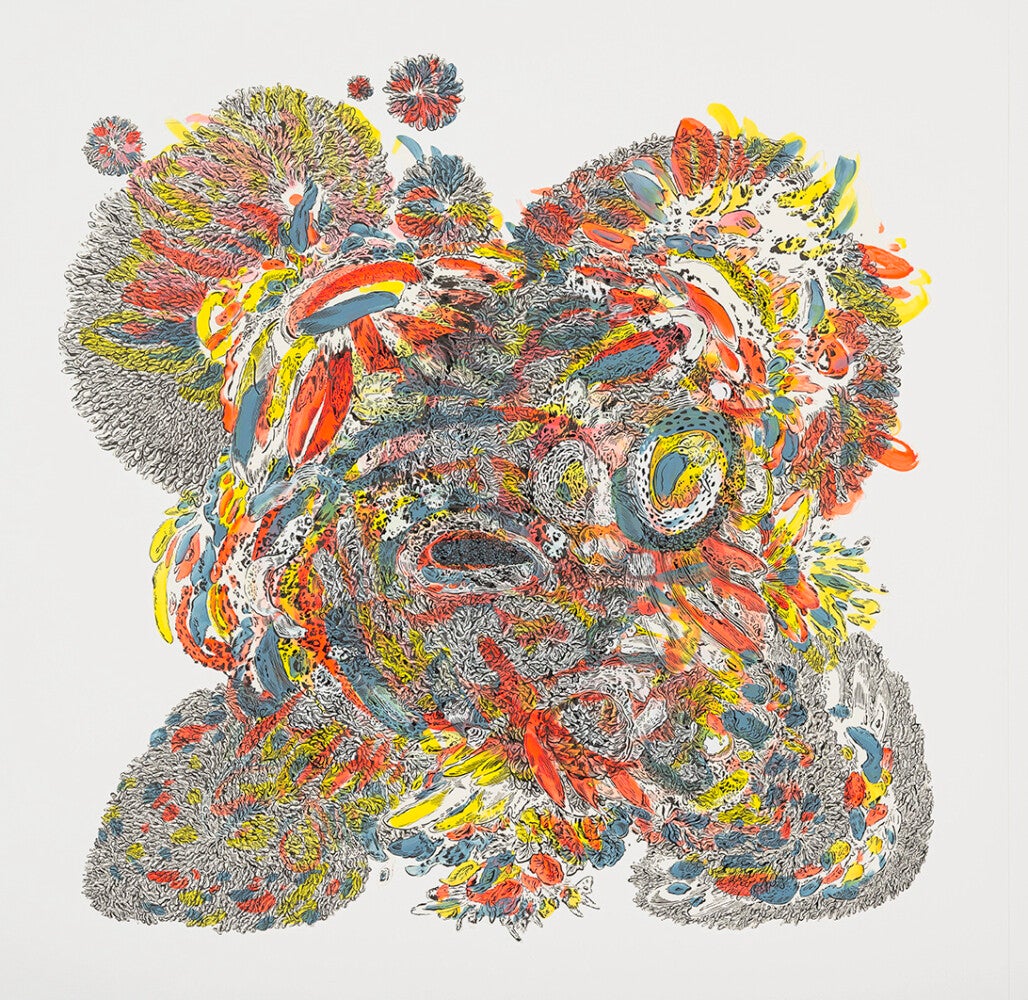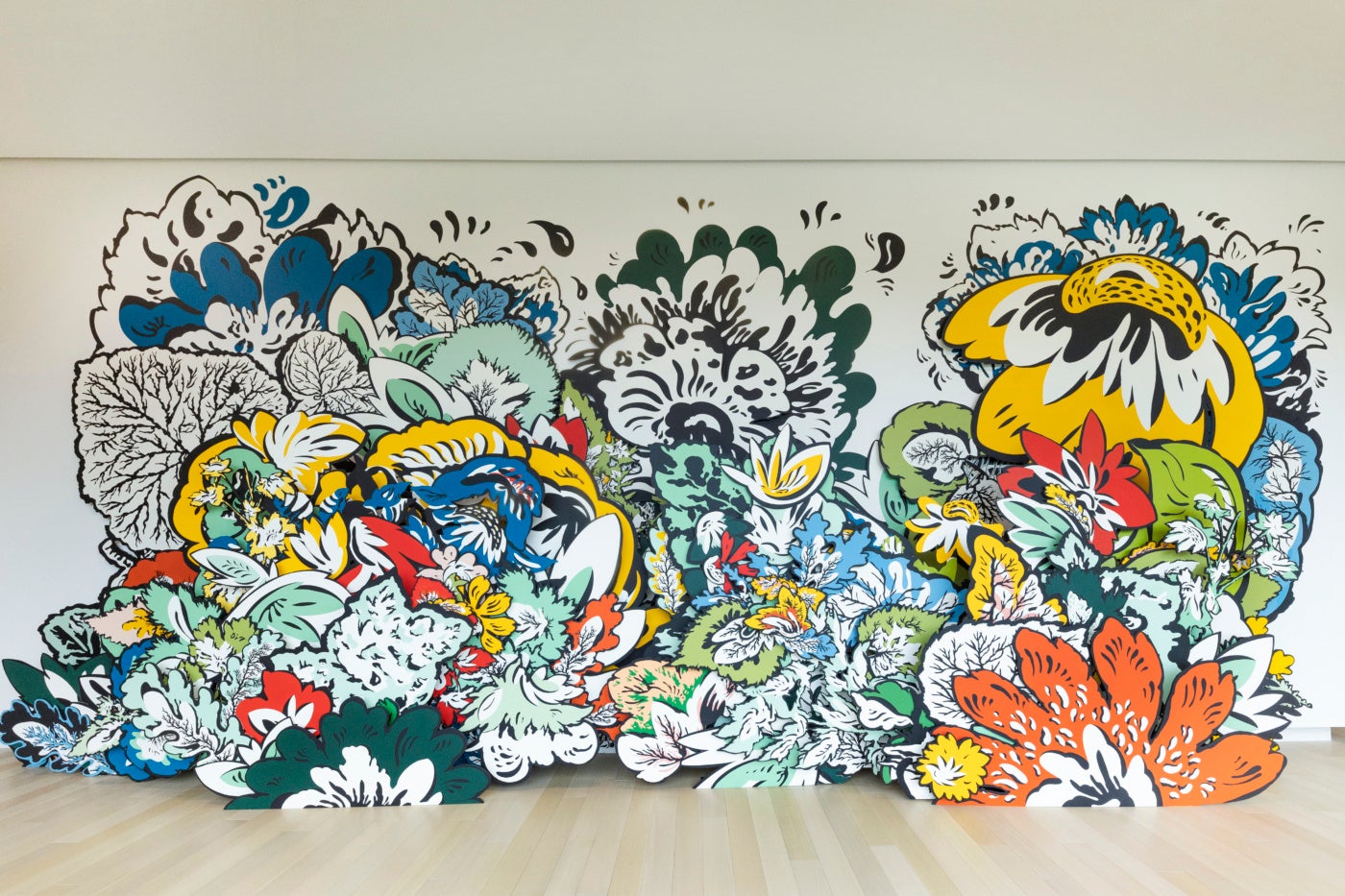
Houston-based artist Natasha Bowdoin is known for her immersive site-specific installations that “attempt to conjure nature.” Her work features immense paper cut-outs of imagined natural forms inspired by Victorian floriographies, early animation, and the brash palette of Pop Art. Bowdoin works at a scale that challenges the power dynamic between humans and the natural world–decentering human aggrandizement and recalibrating the ability to find humanity’s place in a world that thrives on cooperation.
As someone who has studied how the Victorian language of flowers has been used to slyly pass messages, which plants would you choose to compose a bouquet expressing what’s been on your mind lately, and what would they symbolize?
If I think about making work in honor of nature, I would definitely put in ranunculus, which happens to be one of my favorite flowers and was meant to verbalize, “I am dazzled by your charms”—a beautiful sentiment and a total truth. I would also include a flower that signifies “I’m equally terrified of your charms.” What’s interesting about the language of the flowers is that it could express so many different kinds of sentiments, as much to an enemy as to a lover.
What new areas of exploration have you been incorporating into your work, and which early influences are still at play?
What I put into my young mind has really stuck, from really early animation to Pee Wee’s Playhouse–those kinds of madcap graphics, zany, assault-your-eyeballs sort of patterns are very much embraced by cartoon language and graphic arts. There are texts that I’ve put in early, from transcendentalist texts that talk about our relationship to the natural world, or early trickster stories from many different Native American traditions. Fables and folklore have a very fluid notion of what nature even is, and what our role within the natural world can look like. It’s still all very much present in the way I look at my work now.
The newer things feel like threads I haven’t followed very far yet but hope to; I’ve been digging, no pun intended, into the history of radical gardening. The garden becomes a wonderful metaphor and site of activation for all these different ways of being in the world and expressing agency. The other thread I hope to pursue that’s in the zeitgeist right now is thinking about how witchcraft is an interesting arena where nature and certain kinds of feminism have historically intersected … I have a relative on my mom’s side who was actually hanged for witchcraft; she’s part of the monument in Salem that’s meant to recognize the women who were put to death there. So, I have a bit of personal curiosity in following that story and seeing where it might lead.

The witch trials connect to the idea of female agency being something that was feared and subsequently harmed. In that context, I’ve been reading about folk healing modalities and how women were leaders in the field of care when they were persecuted. Those are really rich areas of inquiry that also bring up the idea of reciprocal agency in nature and connect to my next question…
Early cartoons flaunt a kind of animism; everything seems to be alive or at least has the potential to spring into action. How does the aesthetic of early animation inform your work?
By the nature of the medium everything is moving already but, what I love about those early cartoons is that a rock can get up and dance around. I especially love the transformative elements and how they’re almost hallucinogenic. There’s something transgressive about cartoons, even radical in certain respects.
When I’m working in installations with a process that involves drawing, cutting, and then painting through a masking material that gives me that really crisp, smooth, beautiful edge akin to cartoon language–it conjures this feeling of an image that reads right away because it’s so graphic. But then also because of its loopy curviness it can feel like it might be moving into something else or that you’re catching it mid-shift.

Are there any characteristics your creative process shares with flows that can be observed in nature–and do you see creative faculties as being interrupted or imperiled by current technological innovations?
I’ve always tried to make work very organically in the sense that I don’t have a plan at the outset. It’s very improvisational. My own artistic practice is full of gardening metaphors, such as cultivating a lot of raw material first and then cutting away and revealing what’s underneath… .Thinking about the contemporary conditions we’re in and the tech developments we’re facing, my hands are so important in the process. I can’t imagine not doing the making. What I mean by that is the making is synonymous with the thinking; they happen concurrently…like embodied knowledge.
Speaking through flowers became a liberatory language; suddenly a full range of expression could be communicated.
-Natasha Bowdoin
I love that answer because it comes back to the body, and it connects to my next question about the systems of categorizing nature that developed during the “Age of Reason,” as well as concurrent philosophies that bifurcated the mind from the body…You and I once had an interesting conversation about how Enlightenment-era systems of taxonomy have served not only to subjugate the natural world but also groups of people viewed to be in closer relationship with nature. How has your thinking developed on these topics, and how are they explored in your subject matter?
Let me state at the top that I’m looking at this history with an artist’s eye. The knowledge I have on this has been self-directed and thus is always a work in progress. It has been something that has captured my attention over the years as I’ve looked through examples of scientific illustration, as well as histories of how pioneering women–and specifically women artists–have existed in the world. History unfortunately bears out the fact that often the people holding institutional power and doing the examining can’t help but operate under the influence of their own biases. This is made manifest in the ways in which they categorize and assign value, whether they admit it or not. During this era, you can see certain priorities that emerge from bias … There’s always a potential of misunderstanding something if it doesn’t fit into our own realm of experience.
When one looks at the history of classifying nature it’s easy to see the levers of control. No matter the intention of this work there is always a potential for some to use this knowledge to contain, quarantine, confine, or divide the subject under examination—whether that’s an environment as a whole or inhabitants within. If it’s about control, then it’s an easy leap to see how this connects to the history of the subjugation of women and many other marginalized people who were seen as a threat for their own knowledge and experience unfamiliar to patriarchal powers. Women have always posed a threat. They can do things that others cannot, and certain people don’t like that. This flavor of knowledge that is somewhat secret, inaccessible, and unattainable to some, has often led it to be deemed taboo or demonized.
Another example is to consider Indigenous peoples’ knowledge of plant medicine. There’s a rich, deep, longstanding, learned tradition there, but does it manifest in our contemporary Western medical system? There’s some movement in certain places where it’s respected but still many places where it’s deemed not useful and untrustworthy. Historically, of course, there has been a vehement effort to eradicate this critical knowledge entirely.
It’s a history of fear of the unknown, but also an incredible history of resilience and revolutionary acts. The whole practice of the language of flowers, for one, arose out of a need and desire to create the opportunity of full expression for women who at the time were restricted drastically in how they could speak. Speaking through flowers became a liberatory language; suddenly a full range of expression could be communicated. I’m interested in uncovering more histories like these where stories of nature and stories of women become intertwined and where both serve and become advocates for each other.

If nature could speak to us—through the language of flowers, storms, tides, and scorched land—what do you think it would say?
I feel like there are so many indications of nature already doing this.
If I imagine nature speaking to me, I take it back to the concept of the sublime. I feel nature is communicating over a very different sense of time and scale that as one person I could only glimpse pieces of. When you think about communication more broadly that moves away from words, I think you’ll see all kinds of amazing examples of nature talking to itself, and even interspecies communication through touch or sound or stickiness. There are all kinds of amazing ways that one could send a message. Our way of communicating is quite limited.




